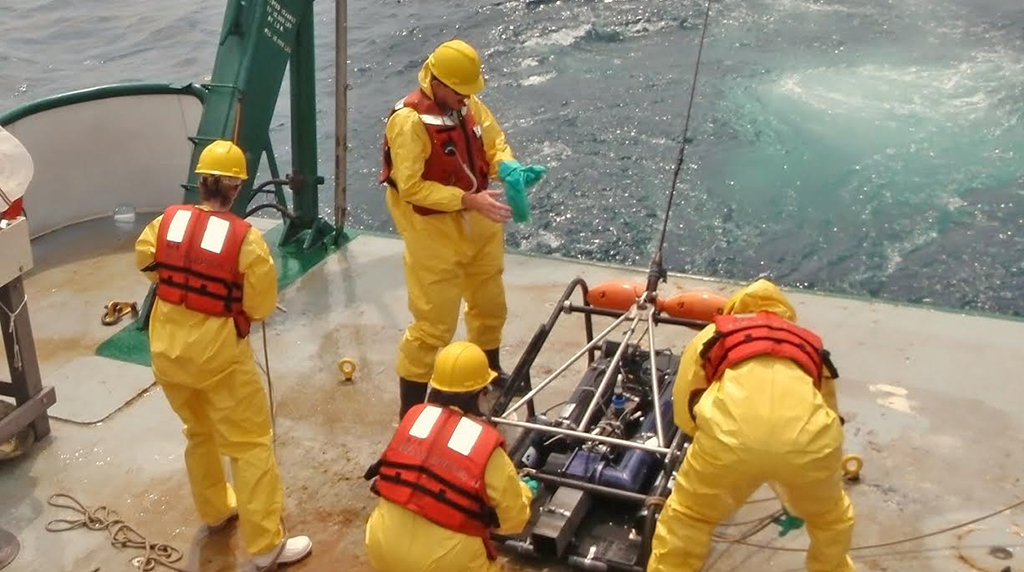January 19, 2017
The researchers discussed the formation and fate of oil-associated marine snow and its ecological impacts on deep-sea environments and made recommendations for future marine oil snow research. The scientists published a report of their findings and discussions in Anthropocene: Assessing the impacts of oil-associated marine snow formation and sedimentation during and after the Deepwater Horizon oil spill.
Study author Kendra Daly summarized the main points from the workshop, “The Deepwater Horizon marine oil snow sedimentation event is recognized to be a significant pathway for oil distribution and fate; marine oil snow formation and sedimentation is influenced by plankton and bacterial dynamics and river discharge of nutrients and suspended minerals; and emergency responders should consider oil sedimentation processes when planning mitigation strategies.”
The authors reported that oil-associated marine snow accounted for as much as 14% of the total oil released during Deepwater Horizon. Sedimented oil on the seafloor may result in prolonged exposure to benthic organisms and economically-important fish. An elevated and extended Mississippi River discharge enhanced phytoplankton production and suspended particle concentrations, zooplankton grazing, and microbial mucus formation.
Daly explained that scientists estimate hundreds of millions of tons of marine snow sink to the seafloor every year, providing food for deep-water animals and playing an important role in the Earth’s natural carbon cycle. Daly described a conceptual framework of MOSSFA processes, “Marine snow occurs everywhere in the world’s oceans, is found at all depths, and is a part of the ocean’s biological pump, which controls how much atmospheric carbon dioxide is absorbed by the ocean and how much carbon sinks into deep water.” Daly explained that as marine snow particles form and sink, they may clump together with other small particles creating small “flakes” of marine snow and that some particles make it to the seafloor and some are eaten by zooplankton and begin their cycle again.
The authors said that marine snow particles are considered hot spots for microbial activity which likely assisted the high microbial degradation rates observed in below-surface oil plumes that formed during and after the spill. Some of the direct and indirect marine ecosystem impacts may have occurred through ingestion, microbial activity, smothering, suboxic and anoxic conditions, transfer through the marine food web, and immunotoxicity through exposure and/or bioaccumulation.
Recommendations for future marine oil snow studies included the influence of sub-sea dispersant application, sub-surface oil plumes, and physical processes (especially large storms); long-term environmental impacts; coupling marine oil snow models to circulation models; and baseline time-series data for all ecosystem levels where hydrocarbon extraction takes place. See the MOSSFA Workshop Report for additional details.
Data are publicly available through the Gulf of Mexico Research Initiative Information and Data Cooperative (GRIIDC) at doi:10.7266/N78P5XFP and doi:10.7266/N76T0JKS.
The study’s authors are Kendra L. Daly, Uta Passow, Jeffrey Chanton, and David Hollander.
************
This article was written by Maggie Dannreuther and originally appeared on the Gulf of Mexico Research Initiative's website here.
This research was made possible by grants from the Gulf of Mexico Research Initiative (GoMRI) to the Center for the Integrated Modeling and Analysis of Gulf Ecosystems (C-IMAGE I), the Center for the Integrated Modeling and Analysis of Gulf Ecosystems II (C-IMAGE II), the Ecosystems Impacts of Oil and Gas Inputs to the Gulf (ECOGIG 1) consortium, the Ecosystem Impacts of Oil and Gas Inputs to the Gulf-2 (ECOGIG-2) consortium, the Deepsea to Coast Connectivity in the Eastern Gulf of Mexico (DEEP-C) consortium, and Florida Institute of Oceanography.
The Gulf of Mexico Research Initiative (GoMRI) is a 10-year independent research program established to study the effect, and the potential associated impact, of hydrocarbon releases on the environment and public health, as well as to develop improved spill mitigation, oil detection, characterization and remediation technologies. An independent and academic 20-member Research Board makes the funding and research direction decisions to ensure the intellectual quality, effectiveness and academic independence of the GoMRI research. All research data, findings and publications will be made publicly available. The program was established through a $500 million financial commitment from BP. For more information, visit http://gulfresearchinitiative.org/.


















 back to top
back to top